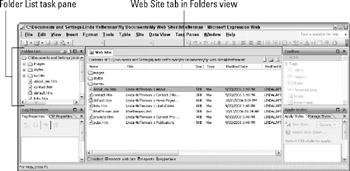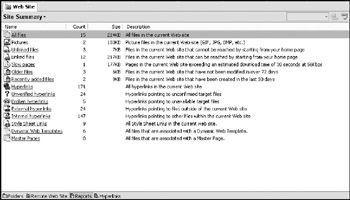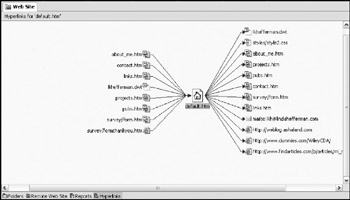Chapter 13: Web Site Management
Using Expression Web, you can do just about anything to change, update, or repair your Web site (assuming that something needs repairing).
In this chapter, you delve into the site-management capabilities of Expression Web. You become familiar with the four Expression Web site-management views. You also discover how to use Expression Web to manage the files that make up your Web site.
Taking In the Views
No doubt you have wondered about that mysterious Web Site tab lurking at the top of the Expression Web design window. The Web Site tab is your doorway to the Expression Web site-management views. Expression Web contains four such views, each of which illuminates your site in a different way.
To switch between views, click the Web Site tab, and then click the appropriate icon at the bottom of the window (see Figure 13-1). Or, choose from the View menu the name of the view you want to see.

Figure 13-1: The contents of the Web Site tab.
Folders view
Folders view of the Web Site tab, shown in Figure 13-1, displays your Web site as a group of files and folders to help you manage and organize your Web site's file system. This view serves the same purpose for your Web site as Windows Explorer serves for the files stored on your hard drive and local network.
| REMEMBER | The Web Site tab Folders view is similar to the Folder List task pane in that it lists files and folders in your Web site. However, Folders view shows only those files and folders contained in the folder that's selected in the Folder List task pane. If you select the top-level folder in the Folder List task pane, Folders view displays all files and folders in the site. If you select a subfolder in the Folder List task pane, Folders view shows only the files and folders located inside that folder. Think of the Folder List task pane as the macro view of your Web site, and think of Folders view of the Web Site tab as the micro view. |
Folders view looks and works much like Windows Explorer:
-
Click a folder in the Folder List task pane to display its contents in the Folders view Contents area.
-
To sort the list of files and folders in the Contents area, click the header label of your choice.
-
To move a page into a folder, click the page icon, drag it on top of the folder, and then release the mouse button. Expression Web updates the page's hyperlinks to reflect its new location. (We talk about how hyper-links work in Chapter 4.)
| REMEMBER | Folders with globe icons denote subsites, which are complete Web sites that live inside a folder of the main, or parent, Web site. To view the contents of a subsite in Folders view, double-click the subsite's folder to open the subsite in a new Expression Web window. We talk more about subsites in the "Working with subsites" section, later in this chapter. |
Reports view
Reports view tells you all sorts of interesting things about your Web site, as shown in Figure 13-2. For example, the Slow Pages report helps you monitor your site's estimated download speed, and the Older Files report reminds you which pages may benefit from an update.

Figure 13-2: Site Summary report in Reports view.
When you first display Reports view, you're greeted by the Site Summary report. This report rounds up useful tidbits of information-including how many hyperlinks and pictures the site contains, how many pages can (and cannot) be reached by following a link from the home page, and how many pages contain broken hyperlinks. This report contains much more information than we list here-see for yourself!
You can click any of the Site Summary report titles that are in blue and underlined to perform a relevant task or to display a more detailed report. Or navigate to the report you want by choosing Site ![]() Reports.
Reports.
Another way to switch between the reports in Reports view is to select the category and name of the report you want to see from the drop-down menu in the upper-left corner of Reports view. To return to the Site Summary report, in the upper-left drop-down menu, select Site Summary.
Most of the reports contain helpful information, but here are the reports we find most useful:
-
Problems/Unlinked Files: This report lists files that don't contain hyperlinks to them.
Take a close look at the pages listed in this report. They may be strays that can be safely deleted because they're effectively cut off from the rest of the site. We show you how to delete pages later in this chapter (although you can probably guess how to do it-select the page and then press the Delete key).
One exception is a confirmation page for a form that pops up after a Web visitor clicks the Submit button on a form. (We talk about forms in Chapter 6.) This page doesn't need any other links to it (although it should contain a link back to some logical place in your Web site-most likely, the site's home page.)
Warning If you delete a page by using Expression Web, you can't later change your mind. Expression Web-deleted pages don't end up in the Recycle Bin-they go to Web-page heaven. If in doubt, leave the page alone.
-
Problems/Slow Pages: Web surfers hate to wait for pages to download. This report helps you keep track of potential slowpokes in your site. The report lists pages that take more than an estimated 30 seconds to load at a connection speed of 28.8 Kbps. We say estimated because download speed depends on several factors, only one of which is page content. (Other factors include the speed of the host Web server, the amount of network traffic at that given moment, and the state of the data lines that make up the Internet, to name a few.)
-
Problems/Broken Hyperlinks: Use this report to test the hyperlinks in your Web site between pages and to verify external links to Web pages on the World Wide Web. We tell you how to use this report in Chapter 4.
Hyperlinks view
The links between the pages in your Web site create a path that visitors follow when they explore the site. Hyperlinks view shows you a road map of the different links in your Web site and how they link to each other.
When you click a page in the Folder List task pane, an icon representing that page appears in the Hyperlinks area of the view. Figure 13-3 shows how a Web site looks in Hyperlinks view.

Figure 13-3: Hyperlinks view.
Small icons with blue arrows pointing to the central page icon illustrate incoming hyperlinks-pages that contain hyperlinks leading to the selected page. Small icons to the right of the central page icon illustrate outgoing hyperlinks-the destinations of the hyperlinks inside the selected page. Broken hyperlinks appear as broken gray lines rather than blue arrows. (We show you how to find and repair broken hyperlinks in your site in Chapter 4.) If the selected page contains no hyperlinks and isn't linked to from any other page in the site, the page icon appears in the Hyperlinks area all by itself.
If you view the contents of your Web site folder in Windows Explorer, no doubt you notice some unfamiliar folders hanging about. All Web sites created with Expression Web contain a standard set of folders that Expression Web uses to store metadata-that is, information about the structure and workings of the site itself. Metadata is the Expression Web way of keeping everything about your site tidy, such as hyperlink information and other page settings so that everything continues to work when you move files around in your Web site. Metadata also keeps your links working when you publish your Web site on the Internet. (We talk about publishing in Chapter 12.) To keep these folders from getting accidentally deleted, moved, or changed, they're hidden inside your Web site and don't show up in Web Site view. Here are the mystery folders and what they keep track of (fret not; you don't need to understand or even open these folders):
-
_vti_cnf: Expression Web uses this folder to store information about each file, such as hyperlinks and page settings.
-
_vti_pvt: This folder stores configuration information about the site itself.
Follow this good general rule: If the folder name begins with an underscore character (_), leave it alone. Folders that Expression Web generates for its own purposes are earmarked with this character.
Few Web sites are one-person operations. Even if you're the lucky staff member who got tapped to put together the company Web or intranet site, you probably need input and cooperation from other members of your team. If those team members are sitting in an office 500 miles away, collaboration can be tricky.
Expression Web comes with some handy tools for managing team collaboration:
Document check-in/check-out: You can set up this option for a Web site on a remote or local site. Choose Site ![]() Site Settings and, on the General tab, select the Use Document Check-In and Check-Out check box to make the options available.
Site Settings and, on the General tab, select the Use Document Check-In and Check-Out check box to make the options available.
Page-level categories, assignments, and status tracking: To access these options, right-click a page in the Folder List task pane and choose File ![]() Properties, and then click the Workgroup tab.
Properties, and then click the Workgroup tab.
If you're looking for a software tool designed exclusively for helping workgroups and teams collaborate via an intranet, Microsoft SharePoint may be the tool for your company. (Find out more at http://www.microsoft.com/sharepoint/default.mspx.) Microsoft Office SharePoint Designer 2007 (http://www.office.microsoft.com/en-us/sharepointdesigner/FX100487631033.aspx), the intranet cousin of Expression Web, helps users custom design their SharePoint sites.
You can modify the Hyperlinks view diagram by right-clicking anywhere inside the view and then choosing one of the following options from the pop-up menu that appears:
-
Show Page Titles: By default, Hyperlinks view displays the page's filenames. Choose this option to display the page's titles instead.
-
Hyperlinks to Pictures: Choose this option to display links to picture files.
-
Repeated Hyperlinks: If the page contains more than one hyperlink to the same destination, Hyperlinks view displays only one instance of the link. Choose this option to make repeated hyperlinks visible.
Remote Web Site view
When you're ready to publish, back up, or move your Web site, you do it in Remote Web Site view. It contains all the tools you need to transfer your Web site's files and folders to a different location-whether it's a host Web server, another computer on your network, or other backup media you choose. We touch on the workings of this view later in this chapter, in the "Backing up and moving a Web site" section, and in Chapter 12, when we show you how to publish your site on the World Wide Web.
EAN: 2147483647
Pages: 142